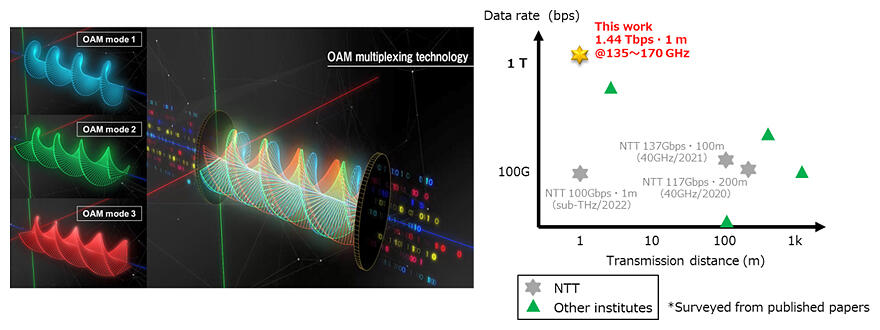With the goal of implementing terabit‐class wireless transmission to support wireless demand into the future, NTT has achieved the world's first OAM (orbital angular momentum) multiplexing high‐capacity wireless transmission at 1.44 Tbit/s (terabits per second) in the sub‐terahertz band, using an ultra‐wide bandwidth of 32 GHz. This is the IOWN concept that NTT, together with its global partners, is aiming to implement. It is a groundbreaking technology that will extend the high‐capacity communications network and information‐processing infrastructure centered on light to wireless networks such as 6G. NTT expects the development of this new technology to lead to the creation and popularization of various future advanced services, including VR (virtual reality), AR (augmented reality), high‐definition video transmission, connected cars and telemedicine. Details of this new technology will be presented at the IEEE ICC (International Conference on Communications) to be held in Rome, Italy from May 28.

Provided by NTT
OAM is one of the physical properties of radio waves, and radio waves with OAM (called OAM waves) can only be received by receivers that have the same helical structure, like the relationship between a bolt and nut, because they have identical trajectories with a helical structure that spirals in the direction of travel. Therefore, multiple OAM waves with different helical structures can be superimposed and separated without their interfering with each other if a receiver that can receive each OAM wave with its corresponding helical structure is used. OAM multiplexing transmission technology uses this feature to transmit multiple data streams simultaneously. These results of research on OAM multiplexing transmission have been reported globally, and NTT has also conducted demonstration experiments of OAM multiplexing transmission at a communication distance exceeding 100 m at 100 Gbit/s using millimeter wave bands.
The newly developed technology is an innovative wireless communication technology that uses the sub‐THz band between 135 and 170 GHz to enable wireless access to a huge amount of information at a data transfer rate exceeding 1 Tbit/s. This technology increases the spatial multiplexing order by multiplexing multiple OAM waves, using an analog circuit called a Butler matrix (Butler circuit). It is characterized by its ability to reduce the enormous amount of digital signal processing required to eliminate interference between radio waves that correspond to different helix structures in high‐capacity communications exceeding 1 Tbit/s.
The developed antenna‐integrated Butler circuit, which operates with a wide bandwidth and low loss, was designed to simultaneously generate and separate eight different OAM waves over a very wide bandwidth between 135 and 170 GHz. Thus, it can be used to multiplex and transmit eight data signals. Moreover, by performing OAM multiplexing transmission with two different polarizations, it is possible to simultaneously multiplex and transmit twice as many data signals (16) without interference.
NTT conducted transmission tests using this circuit and achieved the world's first successful large‐capacity wireless transmission of 1.44 Tbit/s in the sub‐THz bands of 135.5‐151.5 GHz and 152.5‐168.5 GHz. This transmission capacity was equivalent to the simultaneous transmission of approximately 35,000 ultra‐high definition 4K videos (at approximately 40 Mbit/s), like those that are available on current video websites, or the simultaneous transmission of 140 or more uncompressed 4K videos (at approximately 10 Gbit/s) for applications that require ultra‐low latency.
Envisioning various applications that will benefit from the real‐world implementation of the developed OAM multiplex transmission technology in the future, NTT will conduct demonstration experiments over longer distances exceeding 100 m.
This article has been translated by JST with permission from The Science News Ltd. (https://sci-news.co.jp/). Unauthorized reproduction of the article and photographs is prohibited.




